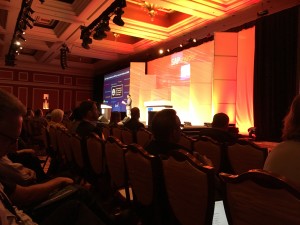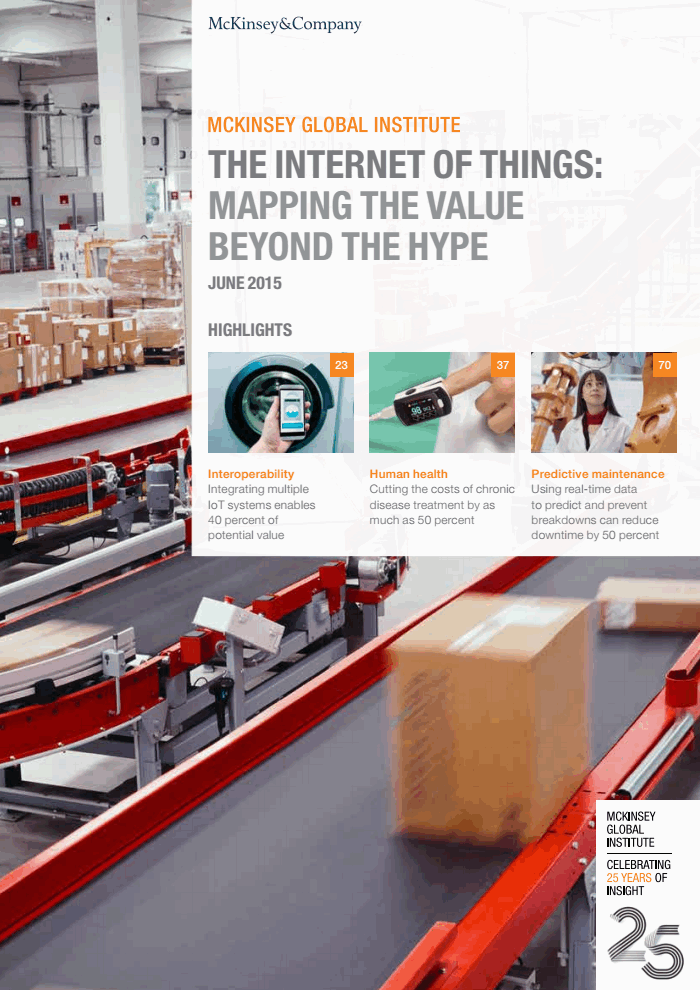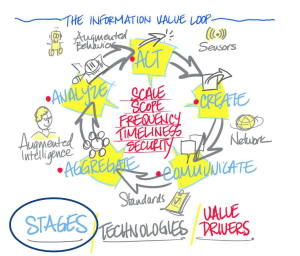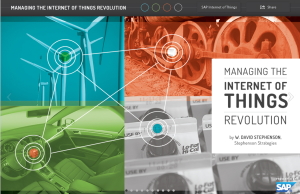Could the IoT’s most profound impact be on management and corporate organization, not just cool devices?
I’ve written before about my still-being-refined vision of the IoT — because it (for the first time!) allows everyone who needs instant access to real-time data to do their jobs and make better decisions to share that data instantly — as the impetus for a management revolution.
My thoughts were provoked by Heppelmann & Porter’s observation that:
“For companies grappling with the transition (to the IoT), organizational issues are now center stage — and there is no playbook. We are just beginning the process of rewriting the organization chart that has been in place for decades.”
If I’m right, the IoT could let us switch from the linear and hierarchical forms that made sense in an era of serious limits to intelligence about things and how they were working at thaFor companies grappling with the transition, organizational issues are now center stage—and there is no playbook. We are just beginning the process of rewriting the organization chart that has been in place for decades.t moment, to circular forms that instead eliminate information “silos” and instead give are circular, with IoT data as the hub.
This article expands on that vision. I’ve tried mightily to get management journals to publish it. Several of the most prestigious have given it a serious look but ultimately passed on it. That may be because it’s crazy, but I believe it is feasible today, and can lead to higher profits, lower operating costs, empowering our entire workforces, and, oh yeah, saving the planet.
Audacious, but, IMHO, valid. Please feel free to share this, to comment on it, and, if you think it has merit, build on it.
Thanks,
W. David Stephenson
The IoT Allows a Radical, Profitable Transformation to Circular Company Structure
by
W. David Stephenson
Precision assembly lines and thermostats you can adjust while away from home are obvious benefits of the Internet of Things (IoT), but it might also trigger a far more sweeping change: swapping outmoded hierarchical and linear organizational forms for new circular ones.
New org charts will be dramatically different because of an important aspect of the IoT overlooked in the understandable fascination with cool devices. The IoT’s most transformational aspect is that, for the first time,
everyone who needs real-time data to do their jobs better or
make better decisions can instantly share it.
That changes everything.
Linear and hierarchical organizational structures were coping mechanisms for the severe limits gathering and sharing data in the past. It made sense then for management, on a top-down basis, to determine which departments got which data, and when.
The Internet of Things changes all of that because of huge volumes of real-time data), plus modern communications tools so all who need the data can share it instantly.
This will allow a radical change in corporate structure and functions from hierarchy: make it cyclical, with real-time IoT data as the hub around which the organization revolves and makes decisions.
Perhaps the closest existing model is W.L. Gore & Associates. The company has always been organized on a “lattice” model, with “no traditional organizational charts, no chains of command, nor predetermined channels of communication.” Instead, they use cross-disciplinary teams including all functions, communicating directly with each other. Teams self-0rganize and most leaders emerge spontaneously.
As Deloitte’s Cathy Benko and Molly Anderson wrote, “Continuing to invest in the future using yesteryear’s industrial blueprint is futile. The lattice redefines workplace suppositions, providing a framework for organizing and advancing a company’s existing incremental efforts into a comprehensive, strategic response to the changing world of work.” Add in the circular form’s real-time data hub, and the benefits are even greater, because everyone on these self-organizing teams works from the same data, at the same time.
You can begin to build such a cyclical company with several incremental IoT-based steps.
One of the most promising is making the product design process cyclical. Designers used to work in a vacuum: no one really knew how the products functioned in the field, so it was hard to target upgrades and improvements. Now, GE has found it can radically alter not only the upgrade process, but also the initial design as well:
“G.E. is adopting practices like releasing stripped-down products quickly, monitoring usage and rapidly changing designs depending on how things are used by customers. ‘We’re getting these offerings done in three, six, nine months,’ (Vice-President of Global Software William Ruh said). ‘It used to take three years.’”
New IoT and data-analytics tools are coming on the market that could facilitate such a shift. GE’s new tool, “Digital Twins,” creates a wire-frame replica of a product in the field (or, for that matter, a human body!) back at the company. Coupled with real-time data on its status, it lets everyone who might need to analyze a product’s real-time status (product designers, maintenance staff, and marketers, for example) to do so simultaneously.
The second step toward a cyclical organization is breaking down information silos.
Since almost every department has some role in creation and sales of every product, doesn’t it make sense to bring them together around a common set of data, to explore how that data could trigger coordinated actions by several departments?
Collaborative big-data analysis tools such as GE’s Predix, SAP’s HANA, and Tableau facilitate the kind of joint scrutiny and “what-if” discussions of real-time data that can make circular teamwork based on IoT-data sharing really achieve its full potential.
The benefits are even greater when you choose to really think in circular terms, sharing instant access to that real-time data not only companywide, but also with external partners, such as your supply chain and distribution network – and even customers – not just giving them some access later on a linear basis. For example, SAP has created an IoT-enabled vending machine. If a customer opts in, s/he is greeted by name, and may be offered “your regular combination” based on past purchases, and/or a real-time discount. That alone would be neat from a marketing standpoint, but SAP also opened the resulting data to others, resulting in important logistics improvements. Real-time machine-to-machine (M2M) data about sales at the new vending machines automatically reroute resupply trucks to those machines currently experiencing the highest sales.
With the IoT, sharing data can make your own product or service more valuable. With the Apple HomeKit, you can say “Siri, it’s time for bed,” and the Hue lights dim, Schlage lock closes, and Ecobee thermostat turns down. By sharing real-time IoT data, each of these companies’ devices become more valuable in combinations than they are by themselves.
Hierarchical and linear management is outmoded in the era of real-time data from smart devices. It is time to begin to replace it with a dynamic, circular model with IoT data as its hub.





